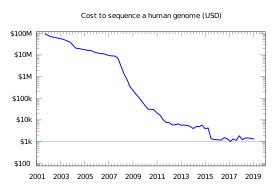Carlson curve
The Carlson curve is a term to describe the rate of DNA sequencing or cost per sequenced base as a function of time.[1] It is the biotechnological equivalent of Moore's law. Robert Carlson predicted that the doubling time of DNA sequencing technologies (measured by cost and performance) would be at least as fast as Moore's law.[2]

History
The term was coined in The Economist[3] and is named after author Rob Carlson.[1]
Carlson curves illustrate the rapid (in some cases above exponential growth) decreases in cost, and increases in performance, of a variety of technologies, including DNA sequencing, DNA synthesis and a range of physical and computational tools used in protein production and in determining protein structures.
The Carlson Curves are always being updated on the synthesis.cc site that Robert Carlson owns. You can find them at http://www.synthesis.cc/synthesis/category/Carlson+Curves
Creator
Robert Carlson is a scientist currently operating out of Seattle, Washington. He has previously written a book called Biology is Technology, worked with the University of Washington, and started his own companies.
Next generation sequencing
Moore's Law started being profoundly out-paced in January 2008 when the centers transitioned from Sanger sequencing to newer DNA sequencing technologies:[4] 454 sequencing with average read length=300-400 bases (10-fold) Illumina and SOLiD sequencing with average read length=50-100 bases (30-fold).
References
http://www.synthesis.cc/synthesis/category/Carlson+Curves
- Robert H. Carlson (April 2011). Biology Is Technology : The Promise, Peril, and New Business of Engineering Life. Cambridge, MA: Harvard University Press.
- Robert Carlson (September 2003). "The Pace and Proliferation of Biological Technologies". Biosecurity and Bioterrorism: Biodefense Strategy, Practice, and Science. 1 (3: 203–214): 203–214. doi:10.1089/153871303769201851. PMID 15040198.
- "Life 2.0". The Economist. August 31, 2006.
- "DNA Sequencing Costs". National Human Genome Research Institute.